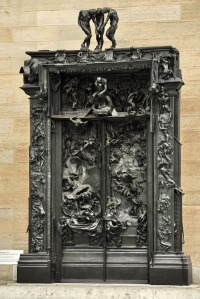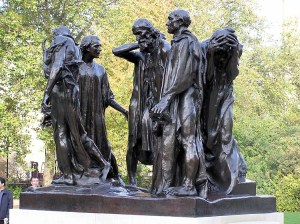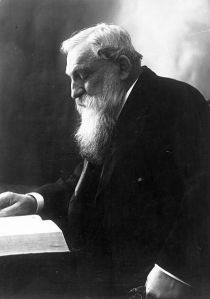Rodin was born in 1840 into a working-class family in Paris, the second child of Marie Cheffer and Jean-Baptiste Rodin, who was a police department clerk. He was largely self-educated, and began to draw at age ten. Between ages 14 and 17, Rodin attended the Petite École, a school specializing in art and mathematics, where he studied drawing and painting. His drawing teacher, Horace Lecoq de Boisbaudran, believed in first developing the personality of his students so that they observed with their own eyes and drew from their recollections. Rodin still expressed appreciation for his teacher much later in life. It was at Petite École that he first met Jules Dalou and Alphonse Legros.
RODIN – View from 1910.
“PROMENADES OF AN IMPRESSIONIST” By JAMES HUNEKER 1910 – contributed by: History of Art and Paintings
Rodin, the French sculptor, deserves well of our new century; the old one did so incontinently batter him. The anguish of his own Hell’s Portal he endured before he moulded its clay between his thick clairvoyant fingers. Misunderstood, therefore misrepresented, he with his pride and obstinacy aroused—the one buttressing the other—was not to be budged from his formulas and practice of sculpture. Then the world of art swung unwillingly and unamiably toward him, perhaps more from curiosity than conviction. Rodin became famous. And he is more misunderstood than ever.
His very name, with its memory of Eugène Sue‘s romantic rancour—you recall that impossible and diabolic Jesuit Rodin in The Mysteries of Paris?—has been thrown in his teeth. He has been called rusé, even a fraud; while the wholesale denunciation of his work as erotic is unluckily still green in our memory. The sculptor, who in 1877 was accused of “faking” his life-like Age of Brass—now at the Luxembourg—by taking a mould from the living model, also experienced the discomfiture of being assured some years later that, not knowing the art of modelling, his statue of Balzac was only an evasion of difficulties. And this to the man who had in the interim wrought so many masterpieces.
To give him his due he stands prosperity not quite as well as he did poverty. In every great artist there is a large area of self-esteem; it is the reservoir which he must, during years of drought and defeat, draw upon to keep his soul fresh. Without the consoling fluid of egoism, genius must perish in the dust of despair. But fill this source to the brim, accelerate the speed of its current, and artistic deterioration may ensue.

The Gates of Hell, a monumental sculptural group depicting scenes from Dante’s Inferno in high relief. Often lacking a clear conception of his major works, Rodin compensated with hard work and a striving for perfection
Rodin has been called, fatuously, the second Michael Angelo—as if there could ever be a replica of any human. He has been hailed as a modern Praxiteles. And he is often damned as a myopic decadent whose insensibility to pure line and deficiency in constructional power have been elevated by his admirers into sorry virtues. Yet is Rodin justly appraised? Do his friends not overdo their glorification, his critics their censure? Nothing so stales a demigod’s image as the perfumes burned before it by his worshippers; the denser the smoke the sooner crumble the feet of their idol.
However, in the case of Rodin the fates have so contrived their malicious game that at no point of his career has he been without the company of envy, chagrin, and slander. Often, when he had attained a summit, he would find himself thrust down into a deeper valley. He has mounted to triumphs and fallen to humiliations, but his spirit has never been quelled, and if each acclivity he scales is steeper, the air atop has grown purer, more stimulating, and the landscape spreads wider before him. He can say with Dante: “La montagna che drizza voi che il mondo fece torti.” Rodin’s mountain has always straightened in him what the world made crooked. The name of his mountain is Art. A born non-conformist, Rodin makes the fourth of that group of nineteenth-century artists—Richard Wagner, Henrik Ibsen, and Edouard Manet—who taught a deaf and blind world to hear and see and think and feel.
Is it not dangerous to say of a genius that his work alone should count, that his life is negligible? Though Rodin has followed Flaubert’s advice to artists to lead ascetic lives that their art might be the more violent, nevertheless his career, colourless as it may seem to those who better love stage players and the watery comedies of society—this laborious life of a poor sculptor—is not to be passed over if we are to make any estimate of his art. He, it is related, always becomes enraged at the word “inspiration,” enraged at the common notion that fire descends from heaven upon the head of the favoured neophyte of art. Rodin believes in but one inspiration—nature. He swears he does not invent, but copies nature. He despises improvisation, has contemptuous words for “fatal facility,” and, being a slow-moving, slow-thinking man, he admits to his councils those who have conquered art, not by assault, but by stealth and after years of hard work. He sympathises with Flaubert’s patient toiling days, he praises Holland because after Paris it seemed slow. “Slowness is a beauty,” he declared. In a word, Rodin has evolved a theory and practice of his art that is the outcome—like all theories, all techniques—of his own temperament. And that temperament is giant-like, massive, ironic, grave, strangely perverse at times; and it is the temperament of a magician doubled by that of a mathematician.
Books are written about him. De Maupassant describes him in Notre Coeur with picturesque precision. He is tempting as a psychologic study. He appeals to the literary, though he is not “literary.” His modelling arouses tempests, either of dispraise or idolatry. To see him steadily, critically, after a visit to his studios in Paris or Meudon, is difficult. If the master be there then you feel the impact of a personality that is as cloudy as the clouds about the base of a mountain and as impressive as the mountain. Yet a pleasant, unassuming, sane man, interested in his clay—absolutely—that is, unless you discover him to be more interested in humanity. If you watch him well you may find yourself well watched; those peering eyes possess a vision that plunges into your soul. And the soul this master of marbles sees as nude as he sees the human body. It is the union of artist and psychologist that places Rodin apart. These two arts he practises in a medium that has hitherto not betrayed potentialities for such almost miraculous performances. Walter Pater is quite right in maintaining that each art has its separate subject-matter; nevertheless, in the debatable province of Rodin’s sculpture we find strange emotional power, hints of the art of painting and a rare musical suggestiveness. But this is not playing the game according to the rules of Lessing and his Laocoön.
Let us drop this old æsthetic rule of thumb and confess that during the last century a new race of artists sprang up from some strange element and, like flying-fish, revealed to a wondering world their composite structures. Thus we find Berlioz painting with his instrumentation; Franz Liszt, Tschaikowsky, and Richard Strauss filling their symphonic poems with drama and poetry, and Richard Wagner inventing an art which he believed to embrace the seven arts. And there is Ibsen, who used the dramatic form as a vehicle for his anarchistic ideas; and Nietzsche, who was such a poet that he was able to sing a mad philosophy into life; and Rossetti, who painted poems and made poetry that is pictorial. Sculpture was the only art that had resisted this universal disintegration, this imbroglio of the arts. No sculptor before Rodin had dared to break the line, dared to shiver the syntax of stone. For sculpture is a static, not a dynamic art—is it not? Let us observe the rules, though we preserve the chill spirit of the cemetery. What Mallarmé attempted to do with French poetry Rodin accomplished in clay. His marbles do not represent but present emotion, are the evocation of emotion itself; as in music, form and substance coalesce. If he does not, as did Mallarmé, arouse “the silent thunder afloat in the leaves,” he can summon from the vasty deep the spirits of love, hate, pain, despair, sin, beauty, ecstasy; above all, ecstasy. Now the primal gift of ecstasy is bestowed upon few. In our age Keats had it, and Shelley; Byron, despite his passion, missed it, and so did Wordsworth. We find it in Swinburne, he had it from the first; but few French poets have it. Like the “cold devils” of Félicien Rops, coiled in frozen ecstasy, the blasts of hell about them, Charles Baudelaire can boast the dangerous attribute. Poe and Heine knew ecstasy, and Liszt also; Wagner was the master adept of his century. Tschaikowsky followed him close; and in the tiny piano scores of Chopin ecstasy is pinioned in a few bars, the soul often rapt to heaven in a phrase. Richard Strauss has shown a rare variation on the theme of ecstasy; voluptuousness troubled by pain, the soul tormented by stranger nuances.

Under French law no more than twelve casts of this piece were permitted after Rodin’s death. The London casting, purchased by the British Government in 1911, is one of those.
Rodin often duplicated parts of his statues. For example two of the heads on this grouping are identical and a third only slightly altered. Some of the hands are used twice.
Rodin is of this tormented choir; he is master of its psychology. It may be the decadence, as any art is in decadence which stakes the parts against the whole. The same was said of Beethoven by the followers of Haydn, and the successors of Richard Strauss will be surely abused quite as violently as the Wagnerites abuse Strauss to-day—employing against him the same critical artillery employed against Wagner. That this ecstasy should be aroused by pictures of love and death, as in the case of Poe and Baudelaire, Wagner and Strauss, must not be adjudged as a black crime. In the Far East they hypnotise neophytes with a bit of broken mirror, for in the kingdom of art, as in the Kingdom of Heaven, there are many mansions. Possibly it was a relic of his early admiration and study of Baudelaire that set Wagner to extorting ecstasy from his orchestra by images of death and love; and no doubt the temperament which seeks such combinations—a temperament commoner in mediæval days than ours—was inherent in Wagner. He makes his Isolde sing mournfully and madly over a corpse and, throwing herself upon the dead body of Tristan, die shaken by the sweet cruel pains of love. Richard Strauss closely patterns after Wagner in his Salome, there is the head of a dead man, and there is the same dissolving ecstasy. Both men play with similar counters—love and death, and death and love. And so Rodin. In Pisa we may see (attributed by Vasari) Orcagna’s fresco of the Triumph of Death. The sting of the flesh and the way of all flesh are inextricably blended in Rodin’s Gate of Hell. His principal reading for forty years has been Dante and Baudelaire. The Divine Comedy and Les Fleurs du Mal are the key-notes in this white symphony of Auguste Rodin’s. Love and life and bitterness and death rule the themes of his marbles. Like Beethoven and Wagner he breaks the academic laws of his art, but then he is Rodin, and where he achieves magnificently lesser men would miserably perish. His large tumultuous music is for his chisel alone to ring out and sing.
“PROMENADES OF AN IMPRESSIONIST” By JAMES HUNEKER 1910 – contributed by: History of Art and Paintings “Rodin was a naturalist, less concerned with monumental expression than with character and emotion”
